Abstract
Murine epidermis contains two types of bone marrow-derived cells of the immune system, Langerhans' cells (LC), which are dendritic antigen-presenting cells, and Thy-1+ dendritic cells (Thy-1+ DEC), which express the gamma/delta T-cell receptor for antigen and hence are probably T cells whose function in the epidermis is unknown. Ultraviolet (UV) light greatly reduces the density of both of these cell types, and hence this may be one of the mechanisms by which UV light induces immunosuppression. It is important to develop strategies for protecting these cells from the effects of UV light. In this study we show that topical all-trans-retinoic acid (RA) and an orally administered retinoid, temarotene, protect both LC and Thy-1+ DEC from being depleted by UV light. However, neither retinoid inhibited the development of immunosuppression in response to application of a contact sensitizer. We also compared two congenic mouse strains, one albino, the other lightly pigmented and capable of tanning in response to UV light. There was no difference in the ability of UV light to deplete LC or Thy-1+ DEC in these two strains or of retinoids to inhibit their depletion. These studies demonstrate that retinoids but not melanin are able to inhibit UV light from depleting LC and Thy-1+ DEC; however, there are other immunosuppressive effects of UV light which are not protected by the retinoids.
Full text
PDF
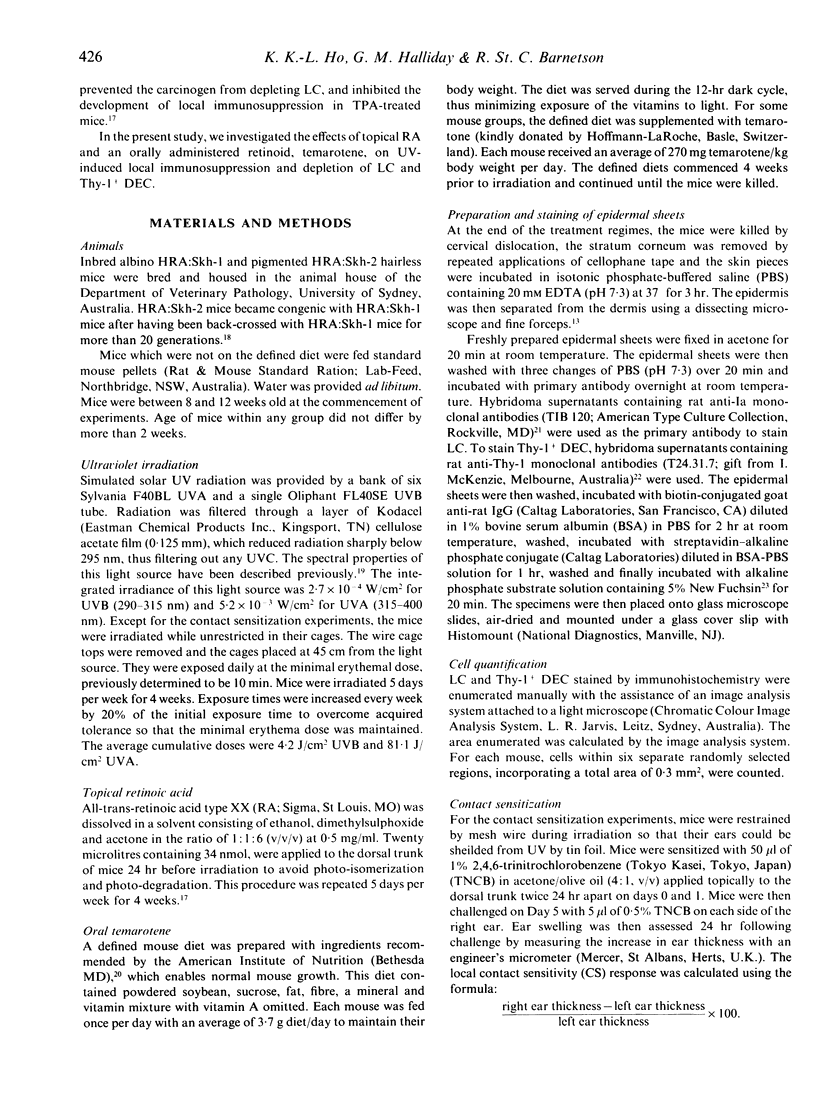
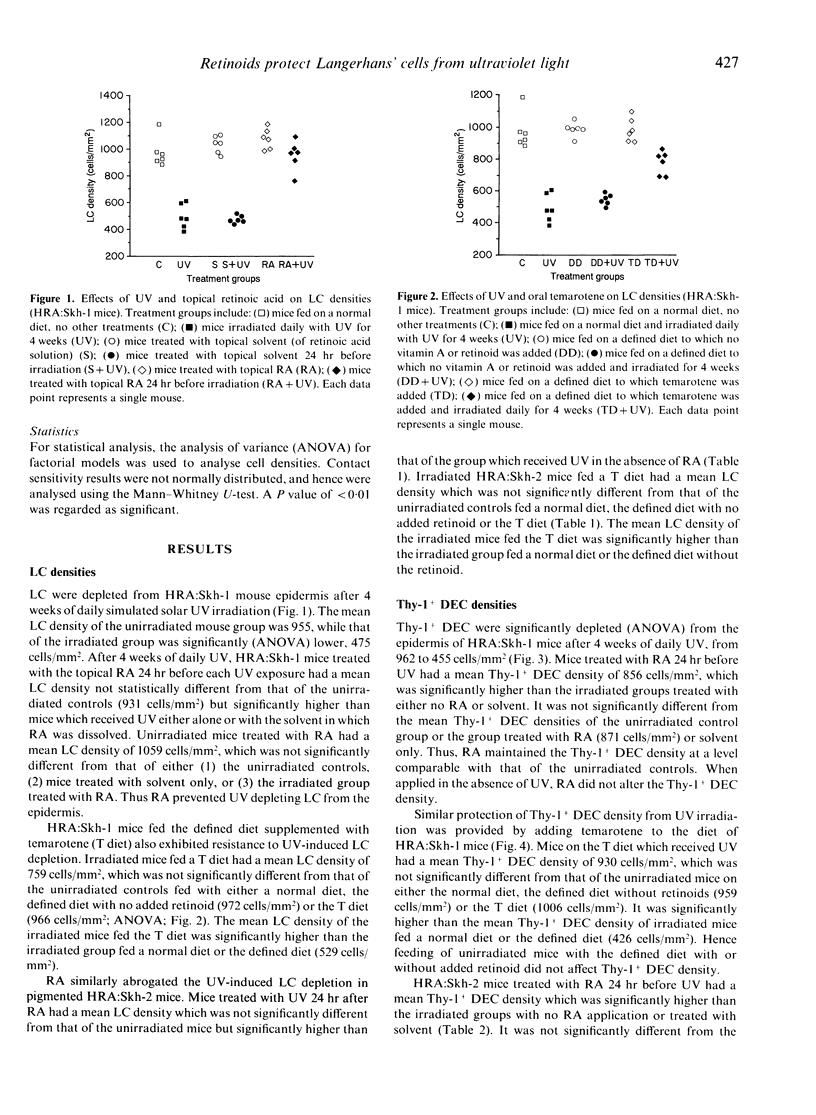
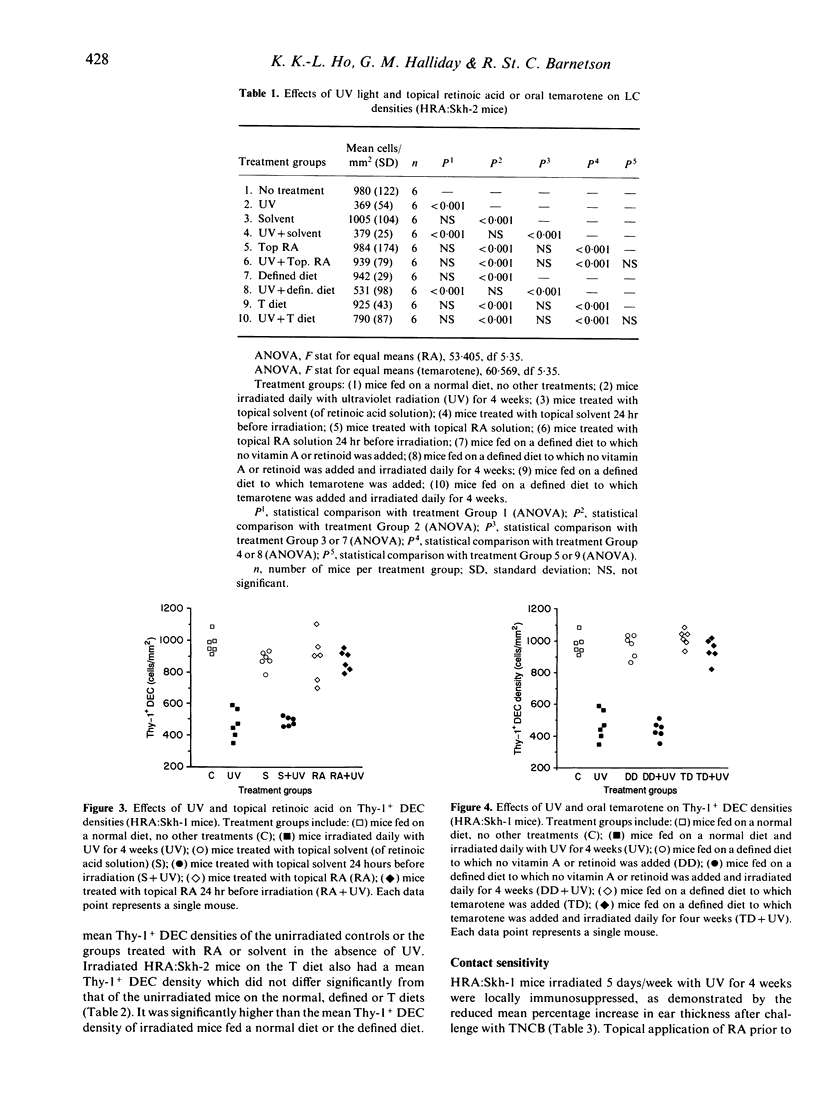
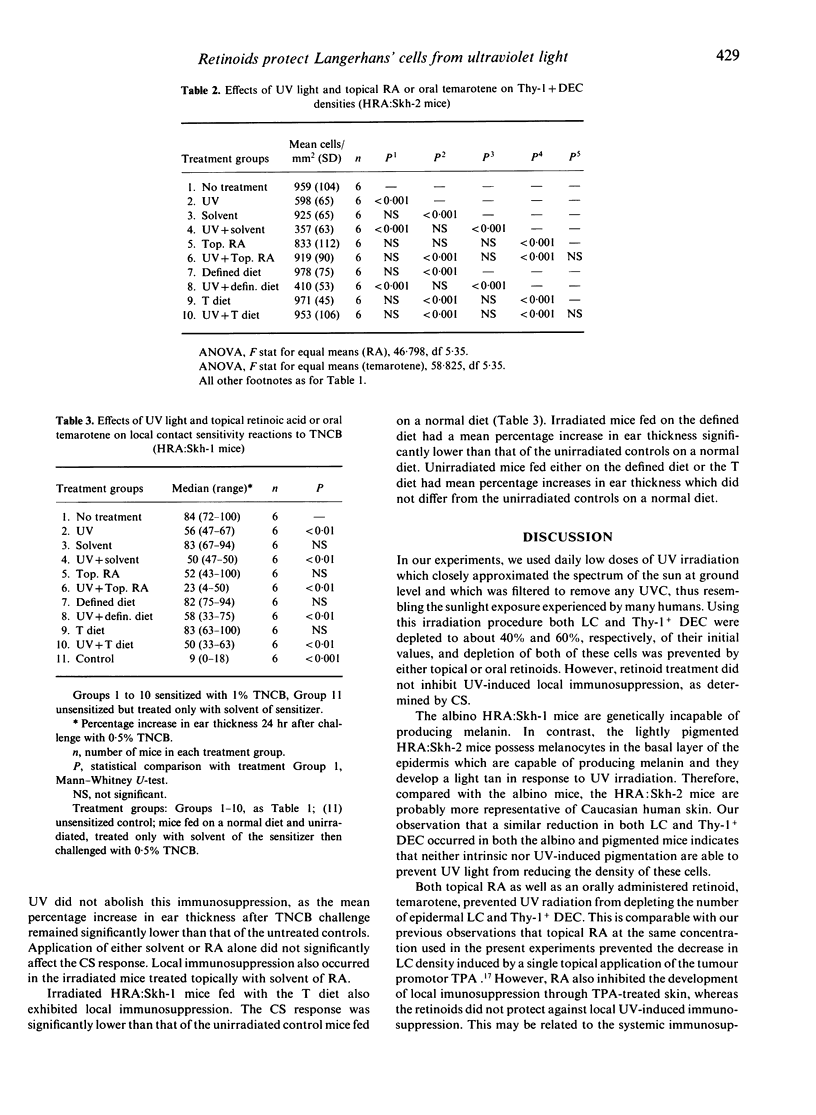
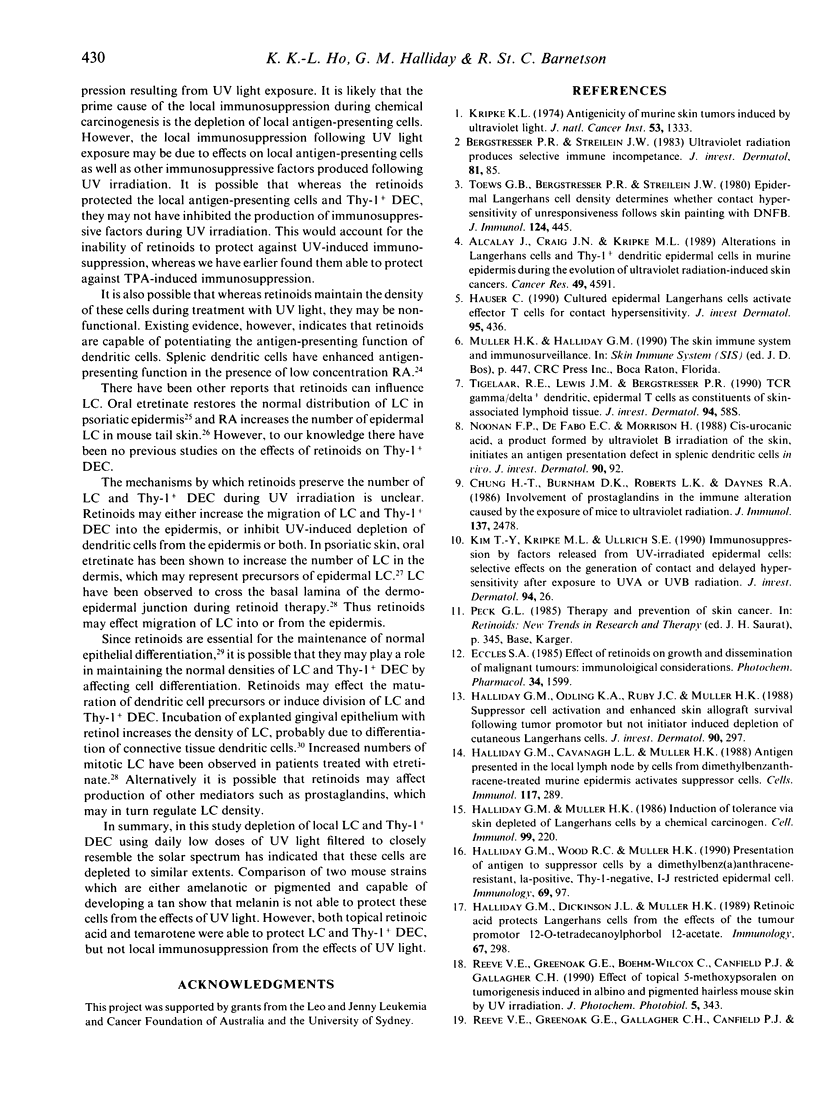
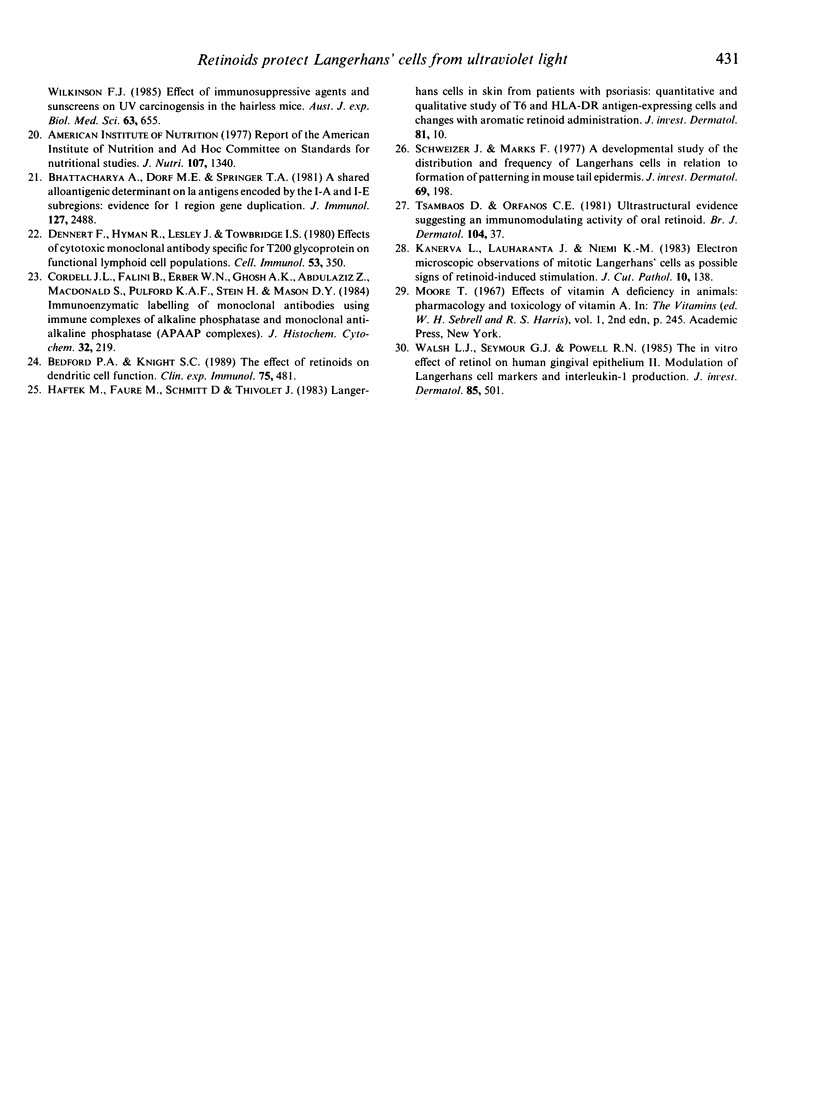
Selected References
These references are in PubMed. This may not be the complete list of references from this article.
- Alcalay J., Craig J. N., Kripke M. L. Alterations in Langerhans cells and Thy-1+ dendritic epidermal cells in murine epidermis during the evolution of ultraviolet radiation-induced skin cancers. Cancer Res. 1989 Aug 15;49(16):4591–4596. [PubMed] [Google Scholar]
- Bhattacharya A., Dorf M. E., Springer T. A. A shared alloantigenic determinant on Ia antigens encoded by the I-A and I-E subregions: evidence for I region gene duplication. J Immunol. 1981 Dec;127(6):2488–2495. [PubMed] [Google Scholar]
- Chung H. T., Burnham D. K., Robertson B., Roberts L. K., Daynes R. A. Involvement of prostaglandins in the immune alterations caused by the exposure of mice to ultraviolet radiation. J Immunol. 1986 Oct 15;137(8):2478–2484. [PubMed] [Google Scholar]
- Cordell J. L., Falini B., Erber W. N., Ghosh A. K., Abdulaziz Z., MacDonald S., Pulford K. A., Stein H., Mason D. Y. Immunoenzymatic labeling of monoclonal antibodies using immune complexes of alkaline phosphatase and monoclonal anti-alkaline phosphatase (APAAP complexes). J Histochem Cytochem. 1984 Feb;32(2):219–229. doi: 10.1177/32.2.6198355. [DOI] [PubMed] [Google Scholar]
- Dennert G., Hyman R., Lesley J., Trowbridge I. S. Effects of cytotoxic monoclonal antibody specific for T200 glycoprotein on functional lymphoid cell populations. Cell Immunol. 1980 Aug 1;53(2):350–364. doi: 10.1016/0008-8749(80)90335-4. [DOI] [PubMed] [Google Scholar]
- Eccles S. A. Effects of retinoids on growth and dissemination of malignant tumours: immunological considerations. Biochem Pharmacol. 1985 May 15;34(10):1599–1610. doi: 10.1016/0006-2952(85)90623-9. [DOI] [PubMed] [Google Scholar]
- Haftek M., Faure M., Schmitt D., Thivolet J. Langerhans cells in skin from patients with psoriasis: quantitative and qualitative study of T6 and HLA-DR antigen-expressing cells and changes with aromatic retinoid administration. J Invest Dermatol. 1983 Jul;81(1):10–14. doi: 10.1111/1523-1747.ep12537454. [DOI] [PubMed] [Google Scholar]
- Halliday G. M., Cavanagh L. L., Muller H. K. Antigen presented in the local lymph node by cells from dimethylbenzanthracene-treated murine epidermis activates suppressor cells. Cell Immunol. 1988 Dec;117(2):289–302. doi: 10.1016/0008-8749(88)90119-0. [DOI] [PubMed] [Google Scholar]
- Halliday G. M., Dickinson J. L., Muller H. K. Retinoic acid protects Langerhans' cells from the effects of the tumour promotor 12-O-tetradecanoylphorbol 13-acetate. Immunology. 1989 Jul;67(3):298–302. [PMC free article] [PubMed] [Google Scholar]
- Halliday G. M., Muller H. K. Induction of tolerance via skin depleted of Langerhans cells by a chemical carcinogen. Cell Immunol. 1986 Apr 15;99(1):220–227. doi: 10.1016/0008-8749(86)90230-3. [DOI] [PubMed] [Google Scholar]
- Halliday G. M., Odling K. A., Ruby J. C., Muller H. K. Suppressor cell activation and enhanced skin allograft survival after tumor promotor but not initiator induced depletion of cutaneous Langerhans cells. J Invest Dermatol. 1988 Mar;90(3):293–297. doi: 10.1111/1523-1747.ep12456077. [DOI] [PubMed] [Google Scholar]
- Halliday G. M., Wood R. C., Muller H. K. Presentation of antigen to suppressor cells by a dimethylbenz (a) anthracene-resistant, Ia-positive, Thy-1-negative, I-J-restricted epidermal cell. Immunology. 1990 Jan;69(1):97–103. [PMC free article] [PubMed] [Google Scholar]
- Hauser C. Cultured epidermal Langerhans cells activate effector T cells for contact sensitivity. J Invest Dermatol. 1990 Oct;95(4):436–440. doi: 10.1111/1523-1747.ep12555587. [DOI] [PubMed] [Google Scholar]
- Kanerva L., Lauharanta J., Niemi K. M. Electron microscopic observations of mitotic Langerhans' cells as possible sign of retinoid-induced stimulation. J Cutan Pathol. 1983 Apr;10(2):138–143. doi: 10.1111/j.1600-0560.1983.tb01487.x. [DOI] [PubMed] [Google Scholar]
- Kim T. Y., Kripke M. L., Ullrich S. E. Immunosuppression by factors released from UV-irradiated epidermal cells: selective effects on the generation of contact and delayed hypersensitivity after exposure to UVA or UVB radiation. J Invest Dermatol. 1990 Jan;94(1):26–32. doi: 10.1111/1523-1747.ep12873322. [DOI] [PubMed] [Google Scholar]
- Kripke M. L. Antigenicity of murine skin tumors induced by ultraviolet light. J Natl Cancer Inst. 1974 Nov;53(5):1333–1336. doi: 10.1093/jnci/53.5.1333. [DOI] [PubMed] [Google Scholar]
- Noonan F. P., De Fabo E. C., Morrison H. Cis-urocanic acid, a product formed by ultraviolet B irradiation of the skin, initiates an antigen presentation defect in splenic dendritic cells in vivo. J Invest Dermatol. 1988 Feb;90(2):92–99. doi: 10.1111/1523-1747.ep12462045. [DOI] [PubMed] [Google Scholar]
- Reeve V. E., Greenoak G. E., Boehm-Wilcox C., Canfield P. J., Gallagher C. H. Effect on topical 5-methoxypsoralen on tumorigenesis induced in albino and pigmented hairless mouse skin by UV irradiation. J Photochem Photobiol B. 1990 May;5(3-4):343–357. doi: 10.1016/1011-1344(90)85050-7. [DOI] [PubMed] [Google Scholar]
- Reeve V. E., Greenoak G. E., Gallagher C. H., Canfield P. J., Wilkinson F. J. Effect of immunosuppressive agents and sunscreens on UV carcinogenesis in the hairless mouse. Aust J Exp Biol Med Sci. 1985 Dec;63(Pt 6):655–665. doi: 10.1038/icb.1985.69. [DOI] [PubMed] [Google Scholar]
- Schweizer J., Marks F. A developmental study of the distribution and frequency of Langerhans cells in relation to formation of patterning in mouse tail epidermis. J Invest Dermatol. 1977 Aug;69(2):198–204. doi: 10.1111/1523-1747.ep12506298. [DOI] [PubMed] [Google Scholar]
- Tigelaar R. E., Lewis J. M., Bergstresser P. R. TCR gamma/delta+ dendritic epidermal T cells as constituents of skin-associated lymphoid tissue. J Invest Dermatol. 1990 Jun;94(6 Suppl):58S–63S. doi: 10.1111/1523-1747.ep12875138. [DOI] [PubMed] [Google Scholar]
- Toews G. B., Bergstresser P. R., Streilein J. W. Epidermal Langerhans cell density determines whether contact hypersensitivity or unresponsiveness follows skin painting with DNFB. J Immunol. 1980 Jan;124(1):445–453. [PubMed] [Google Scholar]
- Walsh L. J., Seymour G. J., Powell R. N. The in vitro effect of retinol on human gingival epithelium. II. Modulation of Langerhans cell markers and interleukin-1 production. J Invest Dermatol. 1985 Dec;85(6):501–506. doi: 10.1111/1523-1747.ep12277300. [DOI] [PubMed] [Google Scholar]


